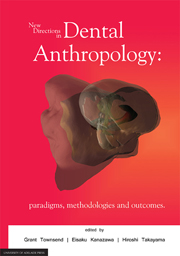Book contents
- Frontmatter
- Foreword
- Contents
- 1 Modelling the complexity of the dentition
- 2 New approaches to dental anthropology based on the study of twins
- 3 Genes for teeth — drawing inference from family data
- 4 Do feeding practices, gestation length, and birth weight affect the timing of emergence of the first primary tooth?
- 5 Sexual dimorphism in the primary and permanent dentitions of twins: an approach to clarifying the role of hormonal factors
- 6 Dental crown and arch size in Europeans and Australian Aboriginals
- 7 Sex determination from maxillary and mandibular canines of the Filipino population
- 8 Non-metric dental characteristics in Papua New Guinea Highlanders and their association with molar reduction
- 9 The Main Occluding Area between opposing teeth during chewing: a comparison between Australians and Japanese
- 10 “Mineral Maintenance” of dental structures in caries and erosive tooth wear: an holistic model
- 11 Emerging techniques for the analysis of tooth wear
2 - New approaches to dental anthropology based on the study of twins
Published online by Cambridge University Press: 05 May 2013
- Frontmatter
- Foreword
- Contents
- 1 Modelling the complexity of the dentition
- 2 New approaches to dental anthropology based on the study of twins
- 3 Genes for teeth — drawing inference from family data
- 4 Do feeding practices, gestation length, and birth weight affect the timing of emergence of the first primary tooth?
- 5 Sexual dimorphism in the primary and permanent dentitions of twins: an approach to clarifying the role of hormonal factors
- 6 Dental crown and arch size in Europeans and Australian Aboriginals
- 7 Sex determination from maxillary and mandibular canines of the Filipino population
- 8 Non-metric dental characteristics in Papua New Guinea Highlanders and their association with molar reduction
- 9 The Main Occluding Area between opposing teeth during chewing: a comparison between Australians and Japanese
- 10 “Mineral Maintenance” of dental structures in caries and erosive tooth wear: an holistic model
- 11 Emerging techniques for the analysis of tooth wear
Summary
ABSTRACT
Studies of twins carried out over the past 25 years by the Craniofacial Biology Research Group at the University of Adelaide have provided insights into the roles of genetic, environmental and epigenetic influences on human dento-facial growth and development. The aim of this paper is to review some of the main findings of these studies and to highlight the value of using different twin models, including the monozygotic (MZ) co-twin design. We also introduce the concept of ‘dental phenomics’ whereby modern 2D and 3D imaging systems are now enabling biologically-meaningful, dental phenotypes to be quantified in order to provide detailed descriptions of the size and shape of teeth. We propose that developments in the field of ‘dental phenomics’, with linking of the data generated to large-scale genome sequencing approaches, should enable us to further unravel the mysteries of how genetic, environmental and epigenetic factors interact to produce the extensive range of morphological variations evident within the human dentition and face.
INTRODUCTION
The Craniofacial Biology Research Group at the University of Adelaide has been involved in studies of the teeth and faces of twins for over 25 years (Townsend et al., 2006). Our main aim is to clarify the roles of genetic, environmental and epigenetic influences on human dento-facial growth and development. Three cohorts of twins have been recruited to enable different objectives and specific hypotheses to be addressed.
- Type
- Chapter
- Information
- New Directions in Dental AnthropologyParadigms, Methodologies and Outcomes, pp. 10 - 21Publisher: The University of Adelaide PressPrint publication year: 2012
- 10
- Cited by



